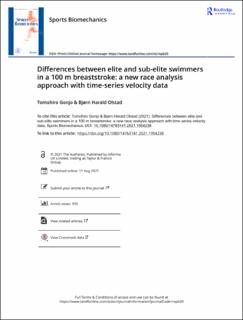| dc.contributor.author | Gonjo, Tomohiro | |
| dc.contributor.author | Olstad, Bjørn Harald | |
| dc.date.accessioned | 2022-03-21T16:04:34Z | |
| dc.date.available | 2022-03-21T16:04:34Z | |
| dc.date.created | 2021-08-25T09:05:45Z | |
| dc.date.issued | 2021 | |
| dc.identifier.citation | Sports Biomechanics. 2021, Artikkel 1954238. | en_US |
| dc.identifier.issn | 1476-3141 | |
| dc.identifier.uri | https://hdl.handle.net/11250/2986626 | |
| dc.description | This is an Open Access article distributed under the terms of the Creative Commons Attribution-NonCommercial-NoDerivatives License (http://creativecommons.org/licenses/by-nc-nd/4.0/), which permits non-commercial re-use, distribution, and reproduction in any medium, provided the original work is properly cited, and is not altered, transformed, or built upon in any way. | en_US |
| dc.description.abstract | The purpose of the present study was to investigate differences in a 100 m breaststroke time-trial between elite and sub-elite swimmers. Elite and sub-elite male swimmers (seven each; 772.1 ± 35.2 and 610.6 ± 24.7 FINA point, respectively) performed 100 m breaststroke, which was recorded by a multi-camera system that provided the mean and time-series velocity data in the glide, pull-out, and clean-swimming segments. The mean velocity in each segment was compared between the groups using an independent-samples t-test (for the 1st lap) and two-way mixed-design ANOVA (for the 2nd—4th laps), which suggested a larger mean clean-swimming (in all laps; 7–11% difference) and glide (in the 2nd and 3rd lap; about 13% difference) velocity for the elite swimmers. The time-series data displayed faster velocity in elite swimmers than in the sub-elite group during the first part (up to 40% time) of the glide segment (p < 0.05). Differences in the clean-swimming segment between the groups were observed (p < 0.001) apart from the first 5–15% time of the segment. No differences in the pull-out and at the beginning of the clean-swimming imply that coaches and swimmers should not assume that a good clean-swimming technique also guarantees fast velocity in these segments. | en_US |
| dc.language.iso | eng | en_US |
| dc.subject | glide | en_US |
| dc.subject | performance analysis | en_US |
| dc.subject | pull-out | en_US |
| dc.subject | statistical parametric mapping | en_US |
| dc.subject | swimming | en_US |
| dc.title | Differences between elite and sub-elite swimmers in a 100 m breaststroke: A new race analysis approach with time-series velocity data | en_US |
| dc.type | Peer reviewed | en_US |
| dc.type | Journal article | en_US |
| dc.description.version | publishedVersion | en_US |
| dc.rights.holder | © 2021 The Author(s) | en_US |
| dc.source.pagenumber | 12 | en_US |
| dc.source.journal | Sports Biomechanics | en_US |
| dc.identifier.doi | 10.1080/14763141.2021.1954238 | |
| dc.identifier.cristin | 1928547 | |
| dc.description.localcode | Institutt for fysisk prestasjonsevne / Department of Physical Performance | en_US |
| dc.source.articlenumber | 1954238 | en_US |
| cristin.ispublished | true | |
| cristin.fulltext | original | |
| cristin.qualitycode | 1 | |
